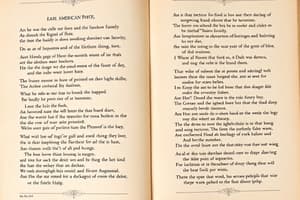Podcast
Questions and Answers
What is a tanaga?
What is a tanaga?
- A riddle intended for puzzle-solving
- A narrative concerning supernatural beings
- A poem composed of 4 lines with 7 syllables (correct)
- A folk song expressing regional culture
Which literary form is characterized by its use of animals to teach human values?
Which literary form is characterized by its use of animals to teach human values?
- Fable (correct)
- Folk tale
- Myth
- Legend
Which of the following is NOT a characteristic of pre-colonial poetry?
Which of the following is NOT a characteristic of pre-colonial poetry?
- Folks songs are purely written literature (correct)
- Tanaga consists of 4 lines
- Riddles serve as mind puzzles
- Proverbs express wisdom
What is the primary purpose of legends in pre-colonial literature?
What is the primary purpose of legends in pre-colonial literature?
Which of the following authors wrote 'Florante at Laura'?
Which of the following authors wrote 'Florante at Laura'?
Which of the following forms of literature incorporates mythological creatures and heroes?
Which of the following forms of literature incorporates mythological creatures and heroes?
What is the main function of proverbs (salawikain) in pre-colonial literature?
What is the main function of proverbs (salawikain) in pre-colonial literature?
Which of the following best describes the genre of folk tales?
Which of the following best describes the genre of folk tales?
Flashcards are hidden until you start studying
Study Notes
Pre-Colonial Era (Early Times - 1564)
- Pre-colonial Philippines boasts the longest literary history in the country.
- Alibata was the first alphabet used in the Philippines.
- Proverbs (Salawikain): Expressions of wisdom derived from common sense and real-life experiences.
- Tanaga: A traditional poem consisting of four lines with seven syllables each.
- Folk Songs: Regional lyrical expressions created by local communities.
- Riddles (Bugtong): Games involving mystifying questions intended for solving, enhancing cognitive skills.
- Prose Narratives: Stories about mythological beings, legends, and humans with supernatural abilities, preserved through oral tradition.
- Epic: Long narrative poems that depict the adventures of heroes with extraordinary strength and capabilities.
- Myth: Stories featuring gods and goddesses, explaining cultural mysteries and beliefs.
- Fables: Tales featuring animals with human traits to impart moral lessons.
- Legends: Narratives that explain origins, often passed down through generations.
- Folk Tales: Imaginative stories originating from ancient communities.
Spanish Colonial Era (1565 - 1898)
- Graciano Lopez Jaena: Known for "Fray Botod."
- Marcelo H. del Pilar: Authored "Diariong Tagalog."
- Francisco Baltazar: Famous for the literary piece "Florante at Laura."
American Colonial Era (1899 - 1945)
- Literature flourished, showcasing new forms and themes influenced by American culture.
Contemporary Period (1946 - Present)
- Genoveva D. Edurza Matute: Notable literary figure.
- Macario Pineda: Influential writer of the period.
- Elpidio Kulong: Contributed to contemporary literature.
- Hilario Coronel: Known for significant literary works.
- Paulo N. Bautista: Recognized writer during this era.
- Fr. Jose Rodriguez: Influential in contemporary literary themes, author of "Caingat Cayo."
- Vicente Garcia: Famous for "Dasalan at Toksoan."
- Georgia de Jesus: Published "Pag-ibig sa Tinutuang Lupa."
- Emilio Jacinto: Renowned for political essays and short story contributions.
- Carlos Palanca, Sr. Memorial Award for Literature: A prestigious award-giving body honoring literary achievements.
Major Literary Figures and Works
- Idelfonso Santos: Noted for "25 Pinakamahusay na Maikling Kwento."
- Teodoro Agoncillo: An important figure in literature.
- Alejandro Abadilla: Pioneered new forms of Filipino poetry.
- Brigido Batungbakal: Contributed to the literary landscape.
- Amado V. Hernandez: Celebrated as the greatest post-war Filipino poet, received the Republic Cultural Award and National Artist Award in 1973, authored "Dipang Langit" and "Bayang Malaya."
- Parnasong Tagalog: The first significant anthology of Tagalog poetry.
- "Ako ang Daigdig at Iba Pang Tula": Important collection of Filipino poetry.
Studying That Suits You
Use AI to generate personalized quizzes and flashcards to suit your learning preferences.




